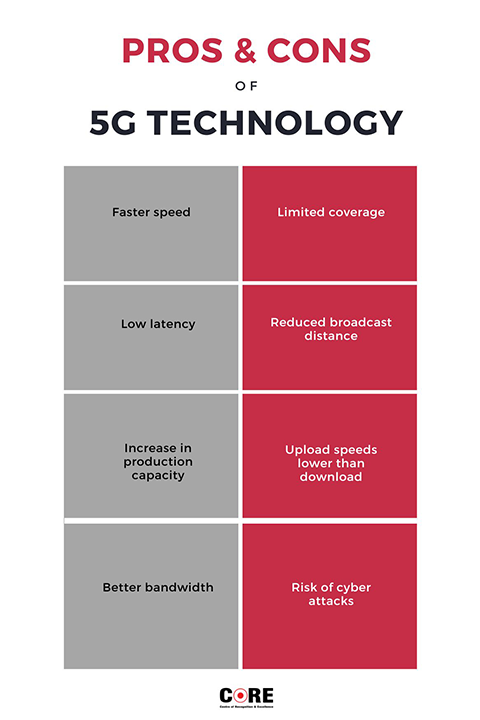In October 2022, 5G was officially rolled out in India, making 13 cities eligible for connectivity in the first phase. With the network's exceptional speed, businesses are eager to integrate it into their ecosystems and facilitate real-time, data-driven decision-making, automation, and transformative industrial innovation. Before we get into the benefits of 5G, let’s take a look at what differentiates it from the other network options:-
What makes 5G a better choice for businesses?

-
Availability of high-speed network
With a 20GB-per-second peak data delivery rate, 5G remains unbeatable in the connectivity race. It provides users with a unified air interface, which enables businesses to orchestrate next-generation user experiences, deploy applications faster, and roll out new services aligning with the changing trends. High-speed connectivity is especially crucial for smart factories aiming to increase and optimize their operational productivity and efficiency by leveraging automation, IoT and IIoT, AR, AI, and other new-age technologies.
-
Significant reduction in latency
5G is specifically designed to deliver lower latency and a consistent user experience and enable consistent connectivity. A standard 5G system should be able to provide a 10 ms E2E (End-to-End) latency on an average and only 1 ms latency for applications that require extremely low latency.
What are the top industrywide benefits of 5G?
1. Effective IoT and IIoT integration in manufacturing
By 2023, the total number of connected devices is expected to increase from 700 million to a massive 3.2 billion. Exceptional data transfer speed is the important factor that sets 5G on its way to commercial success and industries like automotive, manufacturing, agritech, healthcare, telecommunications; and others can develop use cases to integrate this technology into their ecosystems.
For factories and industrial units, downtimes are unaffordable, and the wear-and-tear of the equipment is a necessity. By combining 5G with IoT sensors, these businesses can monitor the health status of machines and delivery vehicles or gather data on machine temperature, electric output, or oil levels without affecting production, automate production and delivery to reduce cost and time, etc. IIoT sensors have the potential to provide wireless access to thousands of square feet and share insights on machine functionality and alerts on maintenance. These sensors can also control the robotics remotely without any interference.
2. Next-Gen healthcare services for remote patients
The pandemic was a big enabler for an increase in the use of digital technologies in healthcare, and 5G provides the foundation for innovation. The example of healthcare workers performing remote diagnostic procedures over 5G in the UK proves the tremendous potential that the technology possesses. Leveraging hyperconnectivity, healthcare professionals can monitor patients’ conditions, hospitals can leverage connected ambulances, HD virtual consultations, online prescription management, AR/VR assistance for the blind, and remote experts for collaboration in surgeries.
3. Uninterrupted digital learning
The digital divide between urban and rural areas is a hurdle in the development of the education sector in India. 5G will open many doors for improved teaching and classroom engagement. It will facilitate digital university development to enable students to learn anytime and anywhere. More importantly, 5G connectivity in rural areas will expose the students from these areas of global education. From AR/VR classrooms, metaverse introduction to classrooms, faster video downloads, full-time assistants for students with special needs, and flexible learning options.
4. Smart farming as a game-changer for developing economies
By adopting 5G, AI, and edge computing, businesses are developing farming systems that are data-driven, precise, customized, and iterative in changing climates. Rather than following a one-size-fits-all approach that does not take into account water/pesticide use, crop yield, or weather patterns, this next-generation approach can ensure a reduction in wastage and improved quality. One great example of technology in agriculture is the fully-automated tractor released by John Deere (a US-based manufacturer of agricultural machinery, heavy equipment, forestry machinery, and so on). This tractor is connected to a mobile app and provides real-time videos, images, metrics, and data.
Another interesting example of clever use of technology is the field weather forecast by Taranis (agriculture intelligence platform) with products capable of offering 8 years of historical data for any field worldwide. 5G makes leveraging such technologies seamless with its speed and reach, especially in a country like India.
5. Reduced turnaround time for the media and entertainment industry
With high-quality, interactive video experiences without any lag or buffering, 5G is the boost that the media and entertainment industry requires. According to a report by Ovum, 5 G-enabled media and entertainment experiences are expected to generate up to $1.3 billion by 2028. It will also increase demand for in-person or live-streaming video content including sports, games, and events. Moreover, 5G opens avenues for personalized advertising for broadcast services, and retail companies, and enhances the adoption of AR/VR use cases for more natural experiences.
Wrapping up
There is no doubt that 5G will open doors to newer business opportunities and innovation. It is bound to help optimize every process in an organization to make it agile, accurate, and data-driven. Businesses are also enthusiastic about developing new use cases to make the most of the lighting fast speed that the network offers. How are you planning to implement 5G into your business? Let us know in the comments below.


